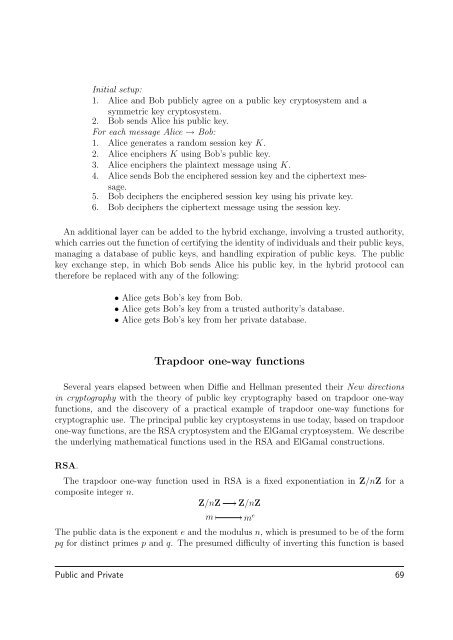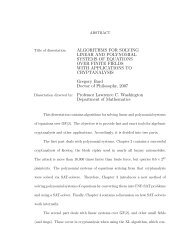Cryptography - Sage
Cryptography - Sage
Cryptography - Sage
You also want an ePaper? Increase the reach of your titles
YUMPU automatically turns print PDFs into web optimized ePapers that Google loves.
Initial setup:1. Alice and Bob publicly agree on a public key cryptosystem and asymmetric key cryptosystem.2. Bob sends Alice his public key.For each message Alice → Bob:1. Alice generates a random session key K.2. Alice enciphers K using Bob’s public key.3. Alice enciphers the plaintext message using K.4. Alice sends Bob the enciphered session key and the ciphertext message.5. Bob deciphers the enciphered session key using his private key.6. Bob deciphers the ciphertext message using the session key.An additional layer can be added to the hybrid exchange, involving a trusted authority,which carries out the function of certifying the identity of individuals and their public keys,managing a database of public keys, and handling expiration of public keys. The publickey exchange step, in which Bob sends Alice his public key, in the hybrid protocol cantherefore be replaced with any of the following:• Alice gets Bob’s key from Bob.• Alice gets Bob’s key from a trusted authority’s database.• Alice gets Bob’s key from her private database.Trapdoor one-way functionsSeveral years elapsed between when Diffie and Hellman presented their New directionsin cryptography with the theory of public key cryptography based on trapdoor one-wayfunctions, and the discovery of a practical example of trapdoor one-way functions forcryptographic use. The principal public key cryptosystems in use today, based on trapdoorone-way functions, are the RSA cryptosystem and the ElGamal cryptosystem. We describethe underlying mathematical functions used in the RSA and ElGamal constructions.RSA.The trapdoor one-way function used in RSA is a fixed exponentiation in Z/nZ for acomposite integer n.Z/nZ Z/nZm m eThe public data is the exponent e and the modulus n, which is presumed to be of the formpq for distinct primes p and q. The presumed difficulty of inverting this function is basedPublic and Private 69
















